No Wire Hangers, ever!
Director Frank Perry is remembered as the director of one of Hollywood’s most famous artistic (though not commercial) disasters, “Mommie Dearest.” Did Mr. Perry get any satisfaction from the fact that Faye Dunaway’s ferocious performance (“No Wire Hangers, ever!”) made his otherwise underwhelming adaptation of Christina Crawford’s memoir and exposé an instant cult classic? This is like asking what veteran director Mark Robson thought about “Valley of the Dolls” (“Sparkle Neely, Sparkle!”) or getting director Paul Verhoeven’s take on “Showgirls” (“Thrust It! Thrust It!”). What is clear is that “Mommie Dearest” was hobbled from the beginning by a dreadful script. A script that Perry himself had a hand in writing.
Cheever, Hunter, and Kaufman.
The irony is that a decade earlier, between 1968 and 1970, Frank Perry directed three great movies. Each was emblematic of its time and place. All three started life as adapted screenplays that captured the spirit of their source material with extraordinary economy and grace. The three films are: “The Swimmer” from 1968, based on the 1964 short story (in the New Yorker) by John Cheever, “Last Summer” from 1969, based on the 1968 novel by Evan Hunter and “Diary of a Mad Housewife” from 1970, based on the 1967 novel by Sue Kaufman. All three screenplays were written by Perry’s then-wife, Eleanor Perry, one of the great screenwriters. These movies were made on the East Coast, outside of the Hollywood system, and were highly influential, if not essential, in establishing the American Independent Film.
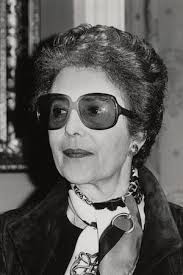
Eleanor Bayer née Rosenfeld, nom-de-plum Oliver Weld Bayer
Eleanor Perry (née Rosenfeld; nom-de-plume Oliver Weld Bayer) had a whole career and a whole other life before she met and married Frank Perry in 1960. He was thirty, and she was forty-five. Even by today’s standards, her life was an astonishingly productive one. Born into a Jewish family in Cleveland, Ohio, in 1914, after attending Case Western Reserve University, she married attorney Leo G. Bayer. Together, they wrote a series of suspense novels. One of them, “Paper Chase” (1942), was even made into an MGM B-movie entitled “Dangerous Partners” in 1945. It was Eleanor’s first taste of Hollywood, even though she was credited under her nom-de-plume. She became interested in psychiatry, getting a master’s degree in psychiatric social work. Her studies in this area would influence her first significant collaboration with Perry, “David and Lisa” (see below), and her last with Bayer. This play, “Third Best Sport,” starring Celeste Holm, ran on Broadway from December 1958 to March 1959. They divorced shortly after. While married to Bayer, she raised two children, one of whom, William Bayer, is a best-selling novelist specializing in psychological crime fiction.

Janet Margolin and Keir Dulea in David and Lisa
Released in 1962, “David and Lisa” was made on a shoestring budget and featured two unknown actors, Keir Dullea and Janet Margolin, making her movie debut. They play troubled teenagers whose paths cross when admitted to a mental health facility. Howard da Silva plays the psychiatrist, making his first movie in 12 years after being blacklisted by Hollywood. Eleanor based the film on the second story from the two-in-one novellas “Jordi/Lisa and David” by Theodore Isaac Rubin. Rubin was an American psychiatrist and author whose work she had read while doing her master’s degree. His specialty was psychoanalysis, then at its zenith in The United States. Many of his beliefs have now fallen out of favor. From today’s vantage point, the movie, despite its sensitive moments, seems dangerously simplistic and naive. Like “Rebel Without a Cause,” the parents are blamed for everything. This is especially true of Dullea’s mother, who thinks of her son only regarding her needs and expectations. “David and Lisa” can be streamed on Amazon Prime Video, Apple TV+, and YouTube.
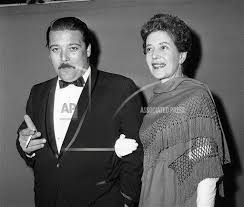
Eleanor and Frank at the 35th Academy Awards in1963
Nevertheless, when the movie was released, it became an art-house sensation, particularly in New York. When the 35th Academy Awards (1962) nominations were announced in early 1963, to everyone’s surprise, Eleanor and Frank were nominated in their respective categories. Eleanor joined the esteemed list of Vladimir Nabokov (“Lolita”), William Gibson (“The Miracle Worker”), Robert Bolt, and Michael Wilson (“Lawrence of Arabia”), and the winner Horton Foote (“To Kill a Mockingbird”) in the Best Adapted Screenplay category. At the same time, Frank found himself in the company of Pietro Germi (“Divorce Italian Style”), Arthur Penn (“The Miracle Worker”), RobertMulligan (“To Kill a Mockingbird”), and the winner, David Lean (“Lawrence of Arabia”) in the Best Director category. Despite its superannuated view of both the causes and treatments of mental illness, Eleanor’s screenplay was adapted into a stage play in 1967 and an Oprah Winfrey-produced TV Movie in 1998.
However, it took about five more years for Eleanor to hit her stride with three perfect adaptations: “The Swimmer,” Last Summer,” and “Diary of a Mad Housewife.”
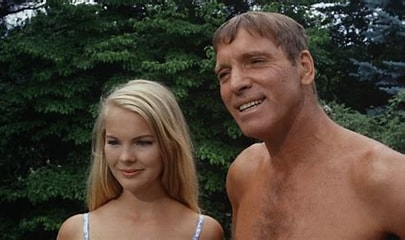
Janet Landgard and Burt Lancaster in The Swimmer.
“The Swimmer” is the most upsetting of the three. In one of his most significant roles, Burt Lancaster is the title character who “swims his way home” through his “river” of backyard swimming pools in affluent, suburban Connecticut. Watching the movie, we gradually realize that what we thought was a nostalgic journey in swimming trunks is a cry from a broken man’s soul. He’s grieving for a life he can never reclaim. That the film finished at all is a minor miracle since producer Sam Spiegel fired Frank Perry after principal photography was completed. Replacing him was Lancaster’s director friend, Sydney Pollack. Pollack shot several transition scenes and replaced several actors in supporting roles, most notably Barbara Loden by Janice Rule. However, although the film is always listed in Pollack’s filmography, Perry got sole directorial credit. The Swimmer can be streamed on Amazon Prime Video, Apple TV+, YouTube and the Criterion Collection.
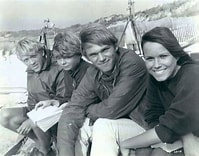
Bruce Davidson, Cathy Burns, Richard Thomas and Barbara Hershey in Last Summer
Eleanor and Frank then turned their attention to Evan Hunter’s just published coming-of-age movie “Last Summer.” Decades before cyberbullying became a public debate, this film captured how cruel young people can be. We are introduced to Peter (Richard Thomas – before he became a household name on “The Waltons”), Dan (Bruce Davidson), and Sandy (Barbara Hershey), three bored teenagers trying to find ways to pass the long, sizzling summer days on the beaches of Fire Island. Thomas and Davison are excellent, prefiguring their later work. But it is Hershey who is stunning as the manipulative Sandy. In “Last Summer,” you see Frank Perry’s strength as a director of actors. Given suitable material by Eleanor, like William Wyler, he had that rare ability to step back and observe, capturing great acting with minimal fuss. One of the movie’s highlights is the exceptional performance of Cathy Burns, who portrays Rhoda, an outsider who yearns to be part of the group. Burns delivers a powerful monologue about her mother’s death, which was filmed in a single take and directed straight to the camera. Although such variations are familiar nowadays, this scene was quite remarkable in 1969 and significantly earned Burns an Oscar nomination for Best Supporting Actress at the 42nd Academy Awards in 1969. Her competitors were Dyan Cannon in “Bob and Carol and Ted and Alice,” Sylvia Miles in “Midnight Cowboy,” and Susannah York in “They Shoot Horses, Don’t They?” The winner was Goldie Hawn in “Cactus Flower.” The movie ends with a brutal rape scene which resulted in the film, like “Midnight Cowboy,” being slapped with an X-rating by the newly formed MPAA. The rape scene was then re-edited so that the movie could be released with an R-rating. This is the version I saw on Irish television. “Last Summer” is not available for Streaming. All original 35mm prints of the film were lost for years. In 2001, a 16mm print was located at the National Film and Sound Archive of Australia after a two-year search and was brought to Los Angeles. It was the only surviving film version of the movie. The film had a rare showing in 2012 by American Cinematheque here in LA. A plea, therefore, to The Criterion Channel, Kino Lorber, and Martin Scorsese to restore this seminal film. The film is also currently NOT available on DVD, Blue-ray or VHS tape. Sadly, the only thing on sale at Amazon is an old movie poster.
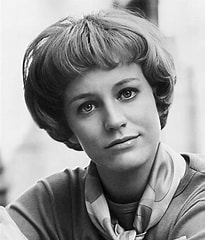
Carrie Snodgress in Diary of a Mad Housewife
Their last movie together, an excellent adaptation of Sue Kaufman’s “Diary of a Mad Housewife,” was their best. The film boasts Carrie Snodgress’ incandescent Tina Balser, one of the great leading performances by an actress. The film is beautifully structured by Eleanor so that the story is always seen from Tina’s point of view. An upper-middle-class housewife who gets no respect from her whining and demanding husband (Richard Benjamin) or her arrogant and demanding lover (Frank Langella making his film debut), Carrie as Tina is a genuine original. She takes shape and grows before our eyes as we realize she is the only sane person in the picture. The film also highlights Frank’s comedic side – he gives the film a subtly humorous subtext. In 1970, everyone was so enraptured by Glenda Jackson in “Women in Love” that they failed to see that it was Snodgress who gave the exceptional performance of 1970 and, although she did nab an Oscar nomination, she should have beaten Jackson, Ali McGraw in “Love Story,” Jane Alexander in ‘The Great White Hope” and Sarah Miles in “Ryan’s Daughter.” Neil Young was so taken with Carrie’s performance that it inspired him to write “A Man Needs a Maid.” The song was included in his 1972 landmark album “Harvest.” Soon after, Young and Snodgress became romantically involved for several years. She moved to his ranch in Northern California, putting her career on the back burner. Unfortunately, it never recovered. “Diary of a Mad Housewife” is currently not available for streaming. The DVD can be purchased from Amazon.
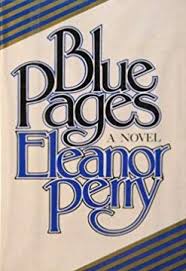
The Marriage is Over.
The Perrys’ marriage was over by this time, and they divorced in 1971. Frank was unfaithful with younger women, and his ego had ballooned to enormous proportions. Eleanor felt used and violated as Frank began to take more and more credit for what was essentially a collaborative relationship. Her1979 Roman à clef “Blue Pages” outlines this in sad yet delicious detail. Eleanor died of cancer in New York in 1981 at age 66. After their divorce, Frank’s career floundered. He directed several films, most of them artistic and commercial failures. The closest he came to artistic success was “Play It as It Lays” with Tuesday Weld. This was adapted by Joan Didion and her husband, John Gregory Dunne, from Joan’s novel of the same name. He had a small commercial success in 1985 with Susan Isaacs’ adaptation of her best-seller “Compromising Positions,” which starred Susan Sarandon and Judith Ivey. However, even these minor achievements lacked something. That something was Eleanor’s intelligence, insight, empathy, and ability to create the perfect script. He was less of a creative force without her.
Diary of a Mad Housewife (1970) Film Review A+ – TheBrownees
Last Summer (1969) Film Review A – TheBrownees


















